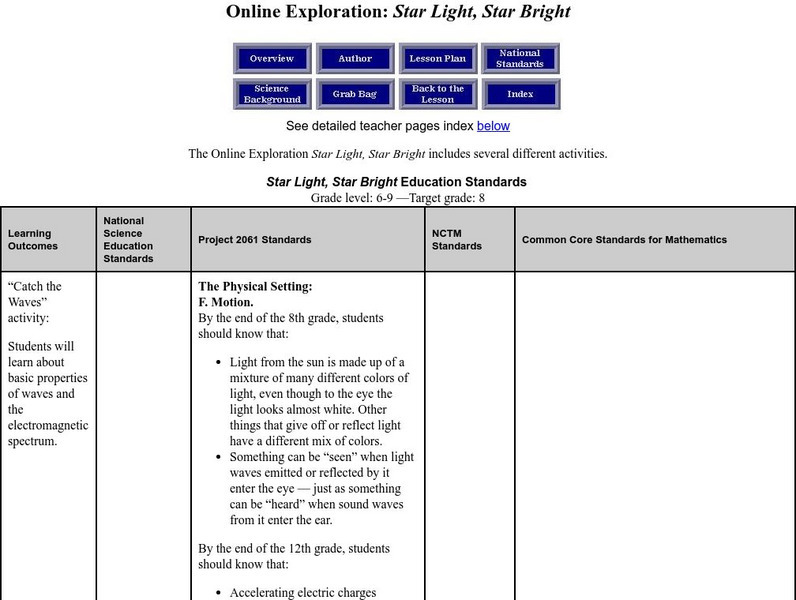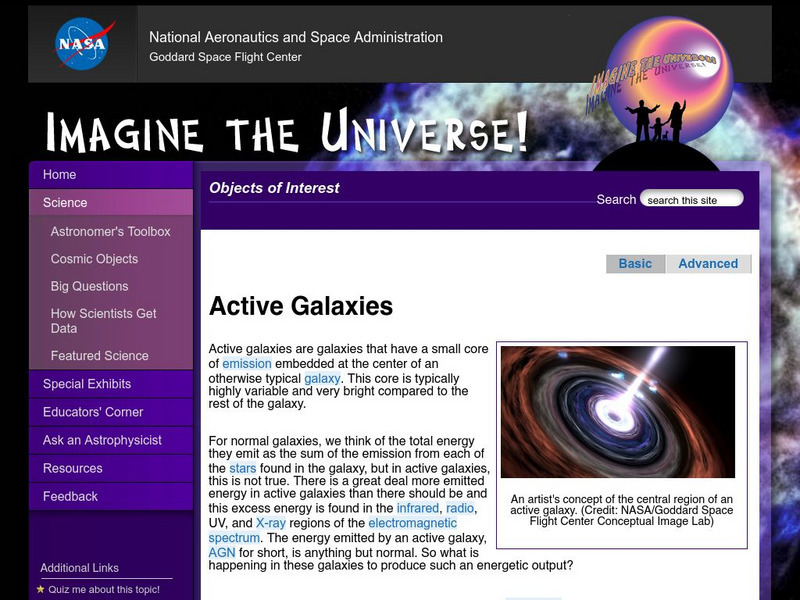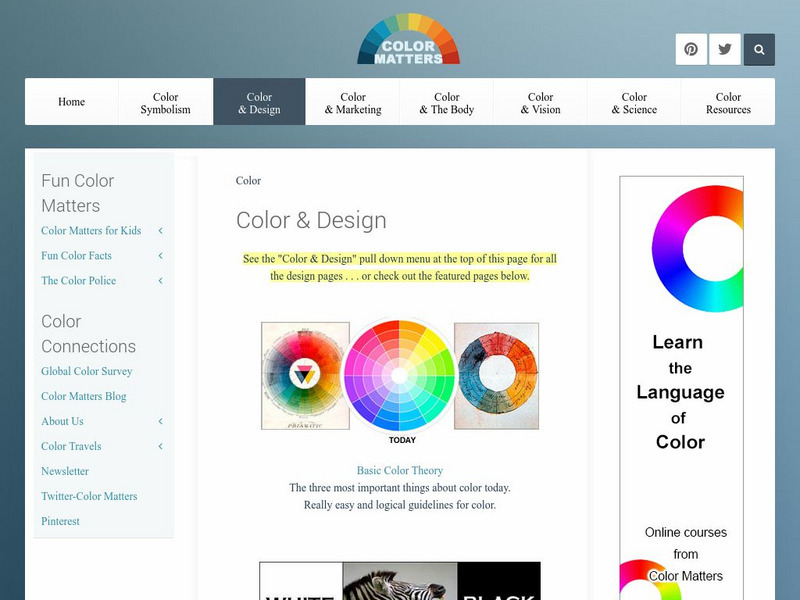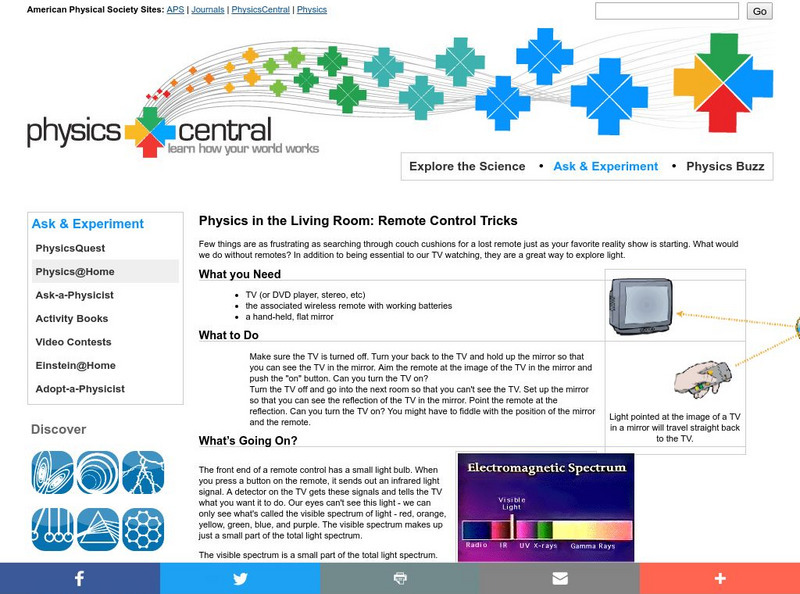Curated OER
Projecting Spectra
Students use two methods to show and study the colors in the visible spectrum.
Georgia State University
Georgia State University: Hyper Physics: Scattering Concepts
A collection of several pages explaining the principles which underlie Rayleigh scattering of light.
Space Telescope Science Institute
Amazing Space: Star Light, Star Bright
This online exploration provides an opportunity to identify the different properties of waves and the relationship that exists between energy, wavelength, and frequency. Correlate images from the Hubble Telescope to the wavelength,...
University of Alberta
The University of Alberta: Infrared Spectroscopy
Complete this interactive tutorial and learn about interpreting the infrared spectrum ("I" "R") that provides information about the functional groups in a molecule. Included are 12 labs and a quiz.
University of Colorado
University of Colorado: Physics 2000: Spectral Lines
Several pages from an excellent site which describe the science of spectroscopy. The unique atomic emission (and absorption) line spectrum of elements are illustrated and explained. Includes a Java applet depicting the quantum energy...
University of Colorado
University of Colorado: Physics 2000: Cat Scans: Projecting Shadows
This page and the three pages which follow discuss how X-ray technology can be used to produce an image of the human body. Discussion is understandable and highly intriguing. Several interactive animations allow the visitor to explore...
University of Colorado
University of Colorado: Physics 2000: Quantum Atom
Several pages with an interesting discussion of the visible light spectrum and atomic absorption and emission line spectrum. Features excellent graphics, thorough and understandable discussion, and many interactive Java applets.
PBS
Pbs Learning Media: Spectrometry Explained
This interactive tutorial illustrates how spectrometry is used to study, identify, and quantify materials.
Canada Science and Technology Museum
Canada Science and Technology Museum: Background Information for Light
Light! How do we see? What makes light? Find out everything you need to know through the Q&As on this site.
Science Education Resource Center at Carleton College
Serc: Using Ph Et Simulations in a Large Lecture Class the Photoelectric Effect
This activity provides a complete curriculum for teaching the photoelectric effect using the PhET Photoelectric Effect simulation in a large-lecture modern physics course.
Other
A Guide to Hazelwood School District v. Kuhlmeier
This site has A Complete Guide to the Supreme Court Decision for this Supreme Court case. It can be downloaded as a PDF file. The article explains many different aspects of the case, including What the Decision Says, What the Decision...
NASA
Nasa: Imagine the Universe: Active Galaxies and Quasars
Describes quasars as being classified within the category of an active galaxy. A description of the emergence of high-energy. Definitions of key words are provided.gamma-ray quasars as an important component of the gamma-ray sky.
TeachEngineering
Teach Engineering: Building a Fancy Spectrograph
Students create and decorate their own spectrographs using simple materials and holographic diffraction gratings. A holographic diffraction grating acts like a prism, showing the visual components of light. After building the...
TeachEngineering
Teach Engineering: Engineering Your Own Spectrograph
Students use simple materials to design an open spectrograph so they can calculate the angle light is bent when it passes through a holographic diffraction grating. A holographic diffraction grating acts like a prism, showing the visual...
TeachEngineering
Teach Engineering: Learning Light's Properties
Students learn the basic properties of light--the concepts of light absorption, transmission, reflection and refraction, as well as the behavior of light during interference. Lecture information briefly addresses the electromagnetic...
Other
Color Matters: Color and Design
This site discusses color and how it works in art, science, and the mind. Explore the many ways that color affects us.
Utah Education Network
Uen: I'm So Bright! I Wear My Shades Indoors!
This lesson engages students in learning about light through multiple sources. Students will learn how light is produced, reflected, refracted, and separated. Students will communicate their findings through an independent project that...
Utah Education Network
Uen: Enlightening Explorations, Part Iii
This lesson contains the following labs: Rainbows, Refraction with Prisms, and What Color Is It? Students will study light by reading various nonfiction texts and viewing a video lesson. Then students will engage in the following labs:...
Utah Education Network
Uen: Enlightening Explorations, Part Ii
This lesson engages students in learning about light. Studets will describe how light is produced, reflected, refracted, and separated.
Chemistry Collective
Chem Collective: Spectroscopic Simulator
A simulation of the vibrational/rotational spectrum of a diatomic molecule (for physical chemistry courses). This simulation of an infra-red spectrometer allows students to adjust the experimental and molecular parameters and observe the...
University of Colorado
University of Colorado: Physics 2000: Electromagnetic Waves
Using a student-teacher dialogue format, this page discusses the nature of light as an electromagnetic wave and the electromagnetic spectrum.
Thomson Reuters
Find Law: u.s. Supreme Court: Hazelwood School District v. Kuhlmeier (1988)
This resource includes information on the Supreme Court case, Hazelwood School District v. Kuhlmeier. The case involves the First Amendment rights of high school students and the publishing of their high school newspaper.
PBS
Pbs Learning Media: Sesame Street: Autism
Share the amazing by celebrating and supporting the uniqueness of every child, including those on the autism spectrum. All children experience the world differently, and those differences are even greater for children with autism. As a...
Physics Central
Physics Central: Physics in the Living Room: Remote Control Tricks
An easy experiment through which students learn about light rays and the electromagnetic spectrum. Requires a TV, its remote, and a hand-held, flat mirror.



















